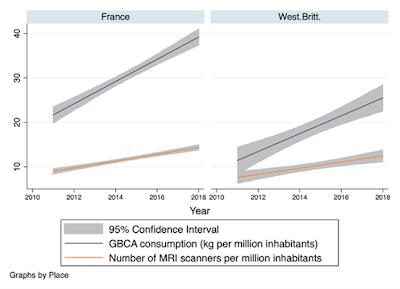
French researchers have assessed national and regional evolution of gadolinium consumption and found that an increase in MRI machines over the past eight years correlates with an increase in annual gadolinium consumption, but gaps remain in protocols to limit the human and environmental impact.
The study team, led by the imaging department at the University Hospital of Brest, pointed to how they hoped that the results would highlight the growing use of gadolinium and help radiologists remain mindful of gadolinium's footprint.
 Dr. Julien Ognard.
Dr. Julien Ognard."We believe that the first step is to update the local injection protocols according to the indications (multiple sclerosis, pituitary gland, etc.) and national/international guidelines or evidence," co-author and radiologist Dr. Julien Ognard told AuntMinnieEurope.com, although the team also noted that no change in practices has been observed in recent years, despite some warnings about gadolinium deposits and environmental consequences.
The study, "Brain MRIs make up the bulk of the gadolinium footprint in medical imaging," by Amandine Chazot and colleagues, was published in the June issue of the Journal of Neuroradiology (June 2020, Vol. 47:4, pp. 259-265). It is based on data collected between 2011 and 2018 from national and universal health registries and Western Brittany's healthcare institutions, about the number of MRI exams and machines and the number of delivered gadolinium-based contrast agents (GBCAs), prescriptions, and administration protocols.
Delivery increase
Over the past eight years, the number of machines implemented in France increased by 62%, with an increase in annual delivered GBCAs in kg up by 64%, and this without modification of the annual quantity of gadolinium used per machine (2.7 kg in 2018), according to the report. In Western Brittany, neuroimaging exams accounted for 50% of all contrast-enhanced exams (50% CI 95% [45; 56]), followed by thorax and abdomen exams (23% CI 95% [18; 28]). The study also revealed that the ratio of injected exams to all exams is greater in public than in private hospitals (respectively 48% CI 95% [46; 49] versus 29% CI 95% [26; 30]).
 Graph shows the evolving trend of GBCA consumption (in kg) per million inhabitants between 2011–2018 with a comparison between France and regional data (West.Britt. : Western Brittany), and the parallel trend in the number of MRI machines per million inhabitants. Image courtesy of Dr. Julien Ognard.
Graph shows the evolving trend of GBCA consumption (in kg) per million inhabitants between 2011–2018 with a comparison between France and regional data (West.Britt. : Western Brittany), and the parallel trend in the number of MRI machines per million inhabitants. Image courtesy of Dr. Julien Ognard.Ognard noted that Western Brittany only had a ratio of 8.3 machines per million inhabitants in 2011 versus 12 in 2018. In comparison, the ratio in France was 9.4 to 14.2 (2011 to 2018) machines per million inhabitants. Consequently, the lower machine numbers partially explain lower gadolinium consumption per million inhabitants in Western Brittany (2.2 kg per machine and 26.6 kg per million inhabitants) in 2018 than in France overall (2.7 kg per machine and 38.9 kg per million inhabitants). However, over the eight years, consumption in kg per million inhabitants had increased 97% in Western Brittany, compared with 64% in France.
The national results seem comparable with other previously published studies, notably from Germany, according to Ognard, who is head assistant of neuroradiology (interventional and diagnostic).
The expansion of indications and diagnostic methods using MRI has led to the rise of MRI machines and examinations leading to increased GBCA use, and medical MRI would appear to be a large contributor to the GBCA footprint in the environment, he noted, pointing to MRI-derived gadolinium pollution detected in hospital sewage, wastewaters effluent, rivers, coastal seawaters, groundwater, tap water, and even fast-food soft drinks, as well as the potential risk of neural tissue retention.
"It is our responsibility to optimize consumption of gadolinium to come to the best diagnosis while keeping in mind environmental pollution and the questions about the effects on humans, with a special consideration for frequent acquisitions," Ognard said.
Future steps
The authors stated that, in an effort to reduce consumption, "alternative methods" such as synthetic MRI or MRA could replace some GBCA-based protocols. While for the moment it is not possible to guarantee the same diagnostic performance when exploring pathologies requiring an MRI with GBCA injection, the radiology department at Brest adapts many exploration protocols to obviate injections. The center performs vascular dynamic imaging without injection and the study of cerebral perfusion.
The team is now conducting more studies on gadolinium consumption on an international scale.



















